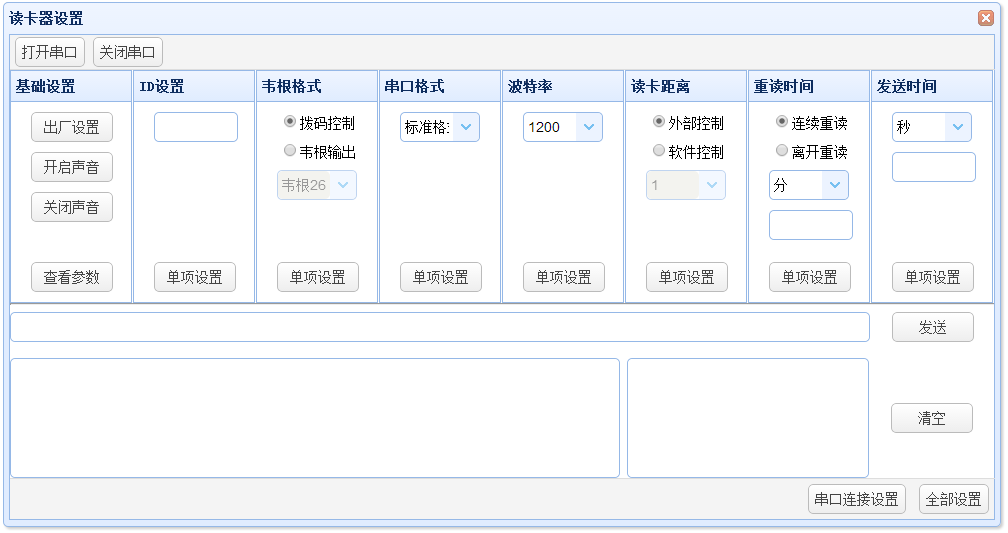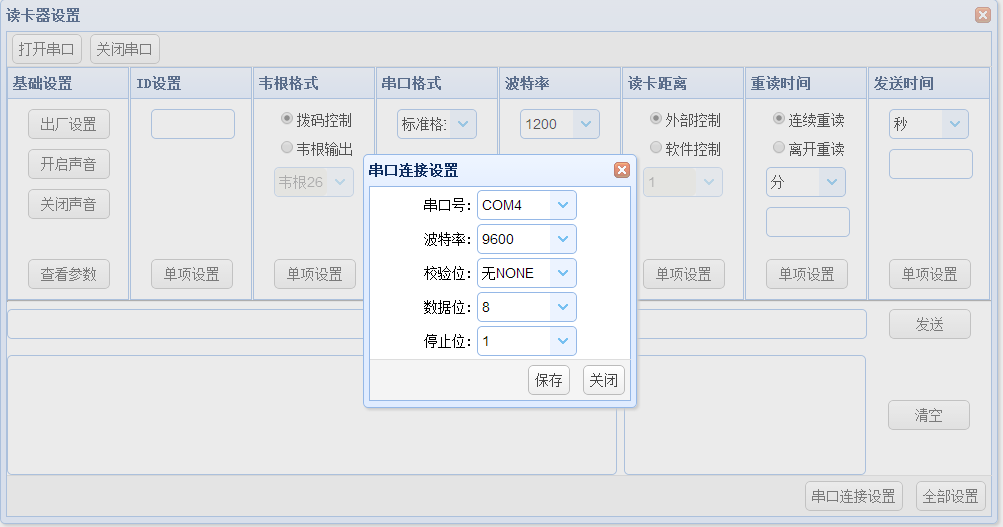原文链接:https://www.cnblogs.com/new-life/p/9345849.html
没想到挺多人需要这个的,很高兴这篇文章能对大家有帮助,主要的工具类博文里已经有了,当然,要小工具源码的留言邮箱即可。
最近接触到了串口及其读写,在此记录java进行串口读写的过程。
1.导入支持java串口通信的jar包:
在maven项目的pom.xml中添加RXTXcomm的依赖 或者 下载RXTXcomm.jar并导入到项目中。
支持Java串口通信操作的jar包,java.comm比较老,而且不支持64位系统,推荐使用Rxtx这个jar包(32位/64位均支持)。
下载地址:
http://files.cnblogs.com/files/Dreamer-1/mfz-rxtx-2.2-20081207-win-x86.zip (32位)
http://files.cnblogs.com/files/Dreamer-1/mfz-rxtx-2.2-20081207-win-x64.zip (64位)
注意:运行过程中抛出 java.lang.UnsatisfiedLinkError 错误或 gnu.io 下的类找不到时,将rxtx解压包中的 rxtxParallel.dll,rxtxSerial.dll 这两个文件复制到 C:\Windows\System32 目录下可解决该错误。(这个需要注意自己电脑的位数)
2.编写代码操作串口:
串口必要参数类:包含连接串口所必须的参数,方便在调用串口时设置和传递串口参数。
1
2
3
4
5
6
7
8
9
10
11
12
13
14
15
16
17
18
19
20
21
22
23
24
25
26
27
28
29
30
31
32
33
|
public class ParamConfig {
private String serialNumber;
private int baudRate;
private int checkoutBit;
private int dataBit;
private int stopBit;
public ParamConfig() {}
public ParamConfig(String serialNumber, int baudRate, int checkoutBit, int dataBit, int stopBit) {
this.serialNumber = serialNumber;
this.baudRate = baudRate;
this.checkoutBit = checkoutBit;
this.dataBit = dataBit;
this.stopBit = stopBit;
}
getter()...
setter()...
}
|
串口操作类:(其中包含的CustomException是自定义异常类,仅用于抛出异常原因。)
1
2
3
4
5
6
7
8
9
10
11
12
13
14
15
16
17
18
19
20
21
22
23
24
25
26
27
28
29
30
31
32
33
34
35
36
37
38
39
40
41
42
43
44
45
46
47
48
49
50
51
52
53
54
55
56
57
58
59
60
61
62
63
64
65
66
67
68
69
70
71
72
73
74
75
76
77
78
79
80
81
82
83
84
85
86
87
88
89
90
91
92
93
94
95
96
97
98
99
100
101
102
103
104
105
106
107
108
109
110
111
112
113
114
115
116
117
118
119
120
121
122
123
124
125
126
127
128
129
130
131
132
133
134
135
136
137
138
139
140
141
142
143
144
145
146
147
148
149
150
151
152
153
154
155
156
157
158
159
160
161
162
163
164
165
166
167
168
169
170
171
172
173
174
175
176
177
178
179
180
181
182
183
184
185
186
187
188
189
190
191
192
193
194
195
196
197
198
199
200
201
202
203
204
205
206
207
208
209
210
211
212
213
214
215
216
217
218
219
220
221
222
223
224
225
226
227
228
229
230
231
232
233
234
235
236
237
238
239
240
241
242
243
244
245
246
247
248
249
250
251
252
253
254
255
256
257
258
259
260
261
262
263
| import gnu.io.CommPortIdentifier;
import gnu.io.PortInUseException;
import gnu.io.SerialPort;
import gnu.io.SerialPortEvent;
import gnu.io.SerialPortEventListener;
import gnu.io.UnsupportedCommOperationException;
public class SerialPortUtils implements SerialPortEventListener {
private CommPortIdentifier commPortId;
private Enumeration<CommPortIdentifier> portList;
private SerialPort serialPort;
private InputStream inputStream;
private OutputStream outputStream;
private String data;
private String dataHex;
@SuppressWarnings("unchecked")
public void init(ParamConfig paramConfig) {
portList = CommPortIdentifier.getPortIdentifiers();
boolean isExsist = false;
while (portList.hasMoreElements()) {
commPortId = portList.nextElement();
if (commPortId.getPortType() == CommPortIdentifier.PORT_SERIAL) {
if (paramConfig.getSerialNumber().equals(commPortId.getName())) {
isExsist = true;
try {
serialPort = (SerialPort) commPortId.open(Object.class.getSimpleName(), 2000);
serialPort.addEventListener(this);
serialPort.notifyOnDataAvailable(true);
serialPort.setSerialPortParams(paramConfig.getBaudRate(), paramConfig.getDataBit(),
paramConfig.getStopBit(), paramConfig.getCheckoutBit());
} catch (PortInUseException e) {
throw new CustomException("端口被占用");
} catch (TooManyListenersException e) {
throw new CustomException("监听器过多");
} catch (UnsupportedCommOperationException e) {
throw new CustomException("不支持的COMM端口操作异常");
}
break;
}
}
}
if (!isExsist) {
throw new CustomException("不存在该串口!");
}
}
@Override
public void serialEvent(SerialPortEvent event) {
switch (event.getEventType()) {
case SerialPortEvent.BI:
case SerialPortEvent.OE:
case SerialPortEvent.FE:
case SerialPortEvent.PE:
case SerialPortEvent.CD:
case SerialPortEvent.CTS:
case SerialPortEvent.DSR:
case SerialPortEvent.RI:
case SerialPortEvent.OUTPUT_BUFFER_EMPTY:
break;
case SerialPortEvent.DATA_AVAILABLE:
readComm();
break;
default:
break;
}
}
public void readComm() {
try {
inputStream = serialPort.getInputStream();
byte[] readBuffer = new byte[inputStream.available()];
int len = 0;
while ((len = inputStream.read(readBuffer)) != -1) {
data = new String(readBuffer, 0, len).trim();
dataHex = bytesToHexString(readBuffer);
System.out.println("data:" + data);
System.out.println("dataHex:" + dataHex);
inputStream.close();
inputStream = null;
break;
}
} catch (IOException e) {
throw new CustomException("读取串口数据时发生IO异常");
}
}
public void sendComm(String data) {
byte[] writerBuffer = null;
try {
writerBuffer = hexToByteArray(data);
} catch (NumberFormatException e) {
throw new CustomException("命令格式错误!");
}
try {
outputStream = serialPort.getOutputStream();
outputStream.write(writerBuffer);
outputStream.flush();
} catch (NullPointerException e) {
throw new CustomException("找不到串口。");
} catch (IOException e) {
throw new CustomException("发送信息到串口时发生IO异常");
}
}
public void closeSerialPort() {
if (serialPort != null) {
serialPort.notifyOnDataAvailable(false);
serialPort.removeEventListener();
if (inputStream != null) {
try {
inputStream.close();
inputStream = null;
} catch (IOException e) {
throw new CustomException("关闭输入流时发生IO异常");
}
}
if (outputStream != null) {
try {
outputStream.close();
outputStream = null;
} catch (IOException e) {
throw new CustomException("关闭输出流时发生IO异常");
}
}
serialPort.close();
serialPort = null;
}
}
public String getDataHex() {
String result = dataHex;
dataHex = null;
return result;
}
public String getData() {
String result = data;
data = null;
return result;
}
public static byte hexToByte(String inHex) {
return (byte) Integer.parseInt(inHex, 16);
}
public static byte[] hexToByteArray(String inHex) {
int hexlen = inHex.length();
byte[] result;
if (hexlen % 2 == 1) {
hexlen++;
result = new byte[(hexlen / 2)];
inHex = "0" + inHex;
} else {
result = new byte[(hexlen / 2)];
}
int j = 0;
for (int i = 0; i < hexlen; i += 2) {
result[j] = hexToByte(inHex.substring(i, i + 2));
j++;
}
return result;
}
public static final String bytesToHexString(byte[] bArray) {
StringBuffer sb = new StringBuffer(bArray.length);
String sTemp;
for (int i = 0; i < bArray.length; i++) {
sTemp = Integer.toHexString(0xFF & bArray[i]);
if (sTemp.length() < 2)
sb.append(0);
sb.append(sTemp.toUpperCase());
}
return sb.toString();
}
}
|
调用串口操作类的代码:
1
2
3
4
5
6
7
8
9
10
11
12
| public static void main(String[] args) {
SerialPortUtils serialPort = new SerialPortUtils();
ParamConfig paramConfig = new ParamConfig("COM4", 9600, 0, 8, 1);
serialPort.init(paramConfig);
serialPort.sendComm("FEF10A000000000000000AFF");
serialPort.closeSerialPort();
}
|
当执行main方法中的代码且未执行关闭串口时,程序将一直处于开启状态,自动监听,接收读取来自串口的数据。
注意:一个串口只能打开一次,并只支持一个程序调用。
以上所记录的是简单测试java是否能成功操作串口数据,至于本人所写的Web端的读卡器调试功能则是在串口操作类的基础上编写网页界面,通过请求来控制串口的开启关闭及相应的设置,功能比较简单,放个界面记录一下:



